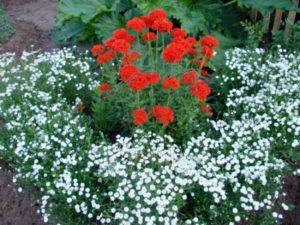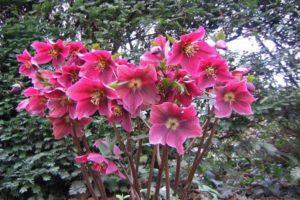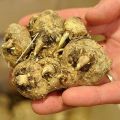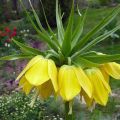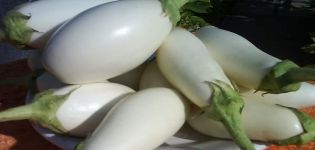Planting and caring for tuberose in the open field, rules for growing and storage
To grow lush tuberose bushes, you should follow the rules of planting and care in the open field. A perennial plant is characterized by beautiful multi-colored inflorescences with a pleasant, persistent aroma. All varieties differ in terms of flowering, growth characteristics, shape and color. Cultivation is carried out in several ways. Care is simple, it involves timely watering, fertilizing, pruning and a number of other activities.
Description and features
Tuberose, another name for polyanthes, is a perennial plant in the Asparagus family. This decorative bush will adorn any flower bed.
And the pleasant notes of inflorescences will spread over large areas:
- The root part is represented by oblong-oval bulbs up to 62 mm in diameter. From above, they are covered with a brown shell with scales. The lower part of the root system is distinguished by long, threadlike branches of a light color.
- The growth of shoots and leaves occurs gradually. In the first season after planting, inflorescences rarely form. After the end of the flowering period, the old tuber dies off, and several young children appear in its place.
- The stem is dense, erect, stretches up to 46 cm.
- The leaves are located only at the bottom of the stem. They are oblong and dark green in color. Leaves grow up to 42 cm in length and 20 mm in width. The upper part of the stem is bare.
- Blooming of buds begins in early July and lasts until mid-autumn.
- On the top of the stem, an inflorescence is formed in the form of an ear. At this time, the height of the bush is 102 cm. The unopened buds are pink. The buds are located on slightly hanging pedicels.
- Each flower blooms for three days. Each stem contains up to 30 large flowers with a pleasant, sweet aroma. The flowers are predominantly white, pink or purple in color. The dense petals seem to be made of wax.
- Flowers are arranged either one at a time or in pairs. The first to bloom are the buds of the lower row.
- After flowering, a ripe fruit remains in the form of a small flat-round box with seeds.
Inflorescence petals are used to create unusual perfume compositions and special cosmetic oils.
Kinds
There are more than 10 types of polyanthes in nature, but only two of them are used in gardening.
Broadleaf
The variety belongs to a perennial group of plants. The flower bulbs grow in the form of a cone up to 6 cm long and 3.5 cm in diameter. The stem is powerful, straight, up to one meter high. The root zone of the stem is densely covered with wide leaves of bright green color. Inflorescences are formed in the form of an ear. The flowers are large, up to 46 mm in diameter, of a snow-white shade with a faint, delicate odor.
Tuberous
All varieties of this variety of tuberose stretch upward to 97 cm. The variety of a flower propagates with large bulbs. Leaves up to 48 cm high germinate from them, similar to the leaves of cereals. The stem is erect, strong. The flowers are arranged in pairs, forming an ear. The inflorescence contains up to 28 flowers of a snow-white tubular color with a strong sweetish aroma.

Popular varieties
All varieties of tuberose are distinguished by beautiful and unusual flowering with a pleasant, delicate aroma.
The pearl
The variety is characterized by semi-double, milky, funnel-shaped inflorescences. Flowering coincides with the last days of June. The height of the bush reaches 86 cm.
Pearl
The plant forms a bush with a height of 46 cm. In one inflorescence up to 32 double flowers with a diameter of up to 56 mm are formed.
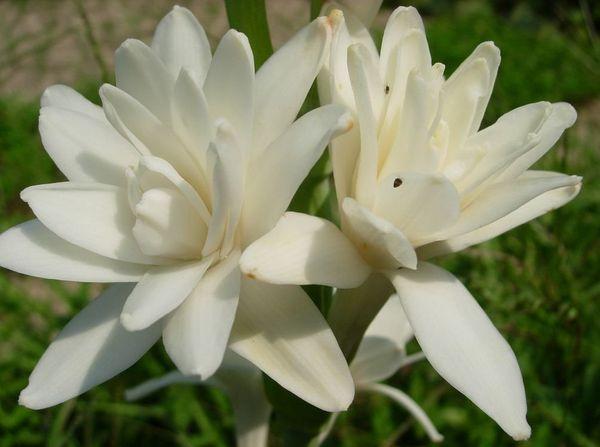
Shringar
On a strong, sturdy stem, attractive pinkish buds are formed.
Sensation
A distinctive feature is that the bush consists of a large number of small lilac-pink inflorescences.
Pink sapphire
The plant is distinguished by large, dense inflorescences of dark purple color. This variety is used for industrial cultivation.
Yellow chrysalis
The decorative variety differs from other tuberose varieties in bright large yellow inflorescences.
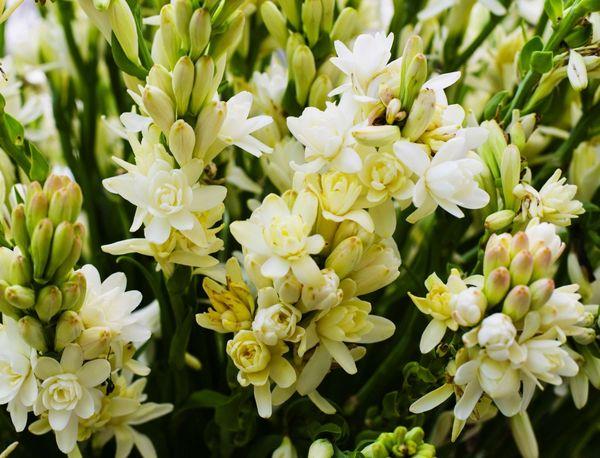
Hindi, or decoration
Flowers of this variety are grown for industrial purposes. The buds begin to open in July. The flowers are pinkish in color.
Growing methods
Most often, tuberose is not immediately planted in an open area, since it does not tolerate cold weather well. It is better to germinate the tubers beforehand.
Usual
Before planting flower tubers in an open area, they should be properly prepared:
- Most gardeners preheat the bulbs. For this purpose, the planting material is laid out on a damp fabric surface. The room should be warm. After the appearance of the first roots, they begin to plant.
- It is also recommended to soak the bulbs in a growth-stimulating solution before planting. Use drugs such as "Zircon" or "Kornevin".
- It is useful to treat the planting material with "Fitosporin" or "Biostim". These drugs will help increase resistance to diseases and pests.
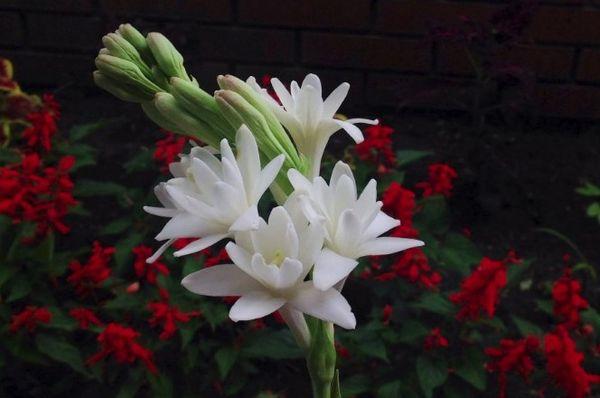
In order for flower bushes to please with lush flowering, it is recommended to follow a number of rules:
- for planting, it is better to choose a sunny area with light shading at lunchtime, always protected from drafts;
- the flower develops well in nutritious, loose soil with good aeration and neutral acidity;
- the planting of tubers is carried out in the last days of April, when the soil warms up to +11 degrees;
- in the selected area, recesses are made up to 3.5 cm at a distance of 16 cm.
Sprouting with moss or peat
Prepared tubers are placed in peat or moss, moved to a warm, dark place. Watering is carried out periodically. As soon as the roots appear, the tubers are planted in containers with prepared soil.
Gladiolus technology
Cultivation using gladioli technology is popular. In the autumn, before the onset of frost, the tubers are dug up, washed and disinfected. Then the planting material should be thoroughly dried. It should be stored at a temperature of +12 degrees, sprinkled with sawdust or sand.
Container
Growing flowers in containers allows you to enjoy flowering much earlier. Tubers are planted in containers already in early February and covered with a small layer of earth. Store until roots appear in a dark and warm place.
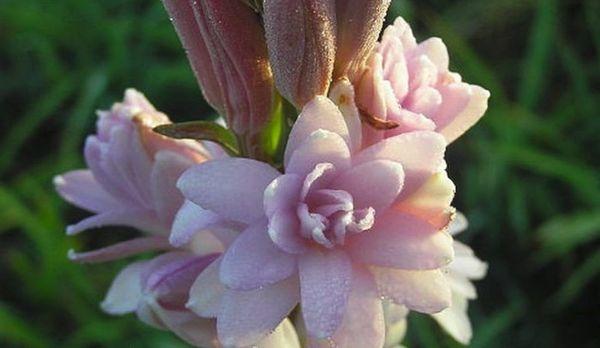
In March, the first roots should appear, and the container is moved to the light. In the future, you should regularly water the plantings. When the weather is warm, the container is taken out into the street, choosing a shaded place. After 12 days, it is permissible to leave the container in the sun.
In the fall, before the onset of frost, the container is brought home again and placed in a dark, cool place.
Care
Since polyantes loves warmth, it is not easy to grow it. The flower makes special demands on air temperature and light. Helpful advice will help you properly care for tuberose.
Watering
Establish regular, moderate watering. On dry days, watered once every two days with warm, settled water. The procedure is carried out in the morning. Irrigation is not carried out in rainy weather.
Top dressing
To make the flowers lush and bright, several dressings are carried out throughout the season. The plant responds well to both mineral and organic compounds.
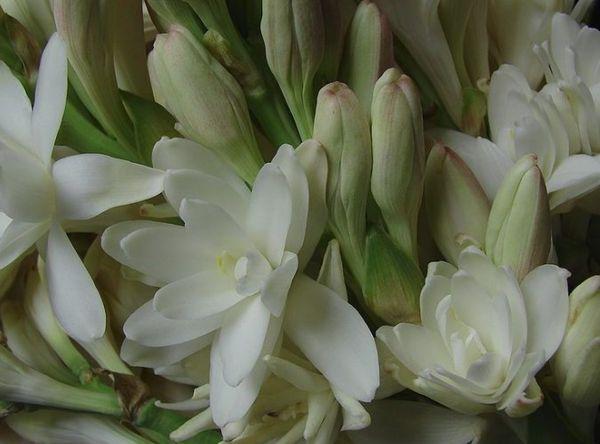
The first introduction of nutrients is carried out before the buds appear, then - during the active blooming of the buds. The last time the introduction of nutrients is carried out after the bush has faded.
Winter storage
The bulbs begin to be dug up after the plant has bloomed and formed a seed capsule. The dates coincide with the second half of autumn. The procedure is carried out carefully so as not to damage the roots.
To maintain the germination of planting material, you need to follow some rules:
- the dug tubers are washed;
- disinfect with a solution of potassium permanganate;
- laid out on the surface and left to dry completely.
Seed material should be stored in a dry, dark place at a temperature of +14 degrees until the spring. It is best to immerse the tubers in sand or sawdust.
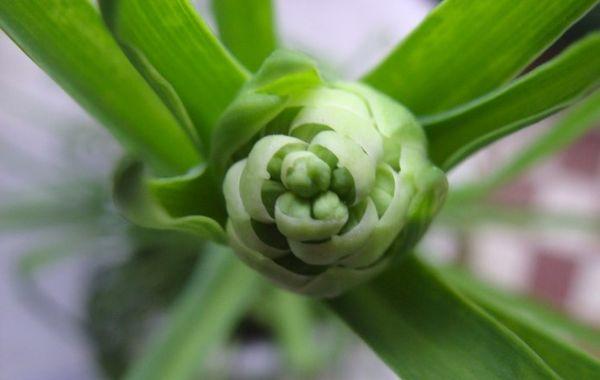
Pruning
Tuberose pruning is carried out in two cases:
- When a flower bush was improperly looked after, and as a result, the stem was very elongated. It is highly likely that the plant will die with the beginning of blooming. In this case, you need to cut off all the leaves. They stop watering the plant and applying fertilizers. The bulbs are dug up and sent to a dark room.
- As soon as the bushes have faded, the yellow, drooping foliage is cut off completely. This is done so that all nutrients are directed to the growth and development of the bulb.
In the process of growth, wilted leaves, damaged shoots and broken inflorescences should be periodically cut off from flower bushes.
Despite the fact that the stems of tuberose are strong, it is recommended to tie them to a support. Strong winds can easily damage the long stem of the plant.
Transplant and reproduction
Polyanthes does not respond well to frequent transplants. Do not start the procedure at the beginning of the growing season. In April, it is permissible to replant tubers only if there has not been a change of place in the last year. If green shoots appear, then the transplant cannot be carried out.
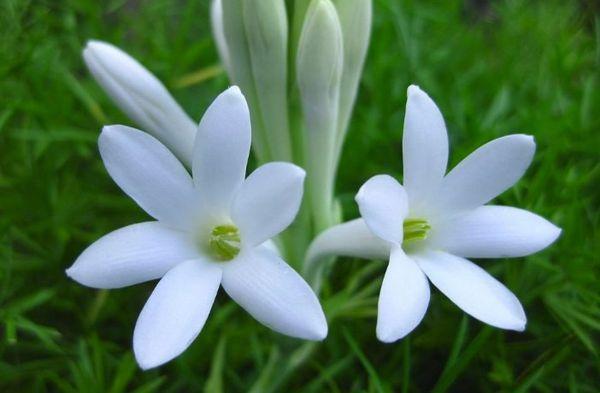
Reproduction of tuberose in most cases occurs in bulbs. The plant is capable of forming up to 10 bulbs in good conditions. Already in July, it is permissible to separate the children from the main tuber. Suitable for transplanting tubers with a diameter of 26 mm.
Seed propagation is only suitable for regions with warm climates. The growing procedure is complicated.
It is necessary to create optimal conditions for the first roots to appear.
Recommendations and features of care
When caring for a heat-loving plant, some points must be taken into account:
- The flower needs good lighting; inflorescences will not appear in the shade. In hot midday, it is better to create a shade for the flower bed.
- The air temperature should not fall below +21 degrees. If the weather is cold, then the growth stops, and flowering does not occur.
- The plant loves high humidity (68-75%). Therefore, periodically the bushes should be sprayed with water.
- The site for planting should be dug up in advance and sand drainage made, since the plant does not tolerate stagnant moisture.
Diseases and pests
Care involves carrying out preventive treatment against infection with various infections and attacks of pests. Gardeners should be aware of the first signs of a problem and be able to deal with it in time.
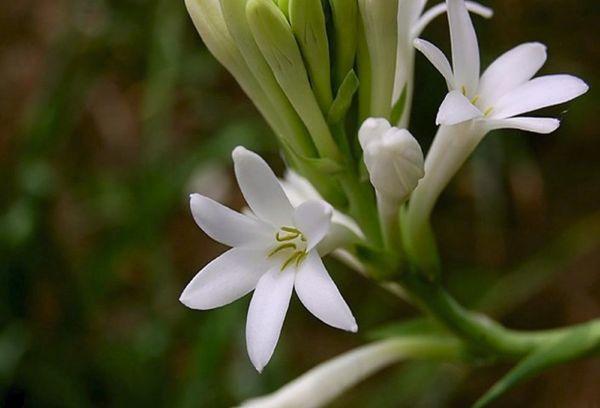
Tuberose pests cause the spread of infections and plant death:
- Often the bulbs of the plant are damaged by the root onion mite. Gradually, the tubers begin to rot, the leaves turn yellow, dry, deform and become covered with a whitish bloom.
- The common bear also spoils the growth of the flower. She eats roots, gnaws at the stems and leaves of the plant. The leaves begin to turn yellow and the growth of the flower slows down.
- Young tuberose sprouts are damaged by aphids. The insect sucks the juices from the plant, as a result, it dries up and dies. The leaves curl up, and dark sticky marks appear on them. The buds, which have time to open, have small flowers of a pale color.
Among tuberose diseases, the most common are the following:
- As a result of gray or white rot, the bush begins to darken, dry and rot. The stem is covered with a grayish bloom. Brown spots are observed on the leaves. The buds become small, soft, quickly wither and fall off. In the fight against the disease will help drugs such as Teldor, Horus.
- Penicillosis is accompanied by the appearance of brown spots on any part of the plant. Over time, the spots become covered with a greenish bloom, and the plant completely rots. The fungus spreads in cool, rainy weather. Chemical preparations will help to cope with the disease: "Maxim", "Fundazol", Bordeaux liquid.
Use in landscape design
Flowers are used to decorate festive bouquets, residential buildings and offices.
Tuberose perfectly complements any flower bed. The combination with gladioli is especially successful. The care for these varieties of flowers is the same. Tuberose looks beautiful in combination with small flowers.
